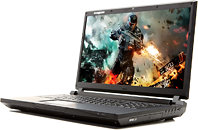- Joined
- Oct 9, 2007
- Messages
- 47,670 (7.43/day)
- Location
- Dublin, Ireland
| System Name | RBMK-1000 |
|---|---|
| Processor | AMD Ryzen 7 5700G |
| Motherboard | Gigabyte B550 AORUS Elite V2 |
| Cooling | DeepCool Gammax L240 V2 |
| Memory | 2x 16GB DDR4-3200 |
| Video Card(s) | Galax RTX 4070 Ti EX |
| Storage | Samsung 990 1TB |
| Display(s) | BenQ 1440p 60 Hz 27-inch |
| Case | Corsair Carbide 100R |
| Audio Device(s) | ASUS SupremeFX S1220A |
| Power Supply | Cooler Master MWE Gold 650W |
| Mouse | ASUS ROG Strix Impact |
| Keyboard | Gamdias Hermes E2 |
| Software | Windows 11 Pro |
The EUROCOM X5 has been stress tested and benchmarked with an Intel Core i7-4930MX processor and NVIDIA GeForce GTX 780M graphics with extreme results. "Eurocom created the X5 gaming laptop so our gaming warrior clients could discover their dark side, the performance and design are unmatched" Mark Bialic, Eurocom President. The EUROCOM X5 will be equipped with high resolution 17.3" 1920x1080 IPS and 3D displays, upgradeable extreme processors, next generation NVIDIA GTX 700M graphics, multiple storage options (up to 5 physical drives) and up to 32 GB of DDR3-1600 memory.
Personalize your own Eurocom laptop weapon with a custom backlit keyboard, with 7 colours, 3 zones and 8 modes to dominate and stand out. To store the latest games and software the X5 can support up to 5 storage drives, with 2 mSATA solid state drives for fast boot up times and blazing responsiveness. The following 4th gen CPUs will be available: Intel Core i7-4930MX with 4 cores and 8 threads running at 3 GHz with 8 MB L3 cache, Intel Core i7-4900MQ, Intel Core i7-4800MQ and Intel Core i7-4700MQ.





Single NVIDIA GeForce GTX 780M Benchmark Results in the EUROCOM X5
Configuration:
View at TechPowerUp Main Site
Personalize your own Eurocom laptop weapon with a custom backlit keyboard, with 7 colours, 3 zones and 8 modes to dominate and stand out. To store the latest games and software the X5 can support up to 5 storage drives, with 2 mSATA solid state drives for fast boot up times and blazing responsiveness. The following 4th gen CPUs will be available: Intel Core i7-4930MX with 4 cores and 8 threads running at 3 GHz with 8 MB L3 cache, Intel Core i7-4900MQ, Intel Core i7-4800MQ and Intel Core i7-4700MQ.





Single NVIDIA GeForce GTX 780M Benchmark Results in the EUROCOM X5
Configuration:
- Intel Core i7-4930MX
- NVIDIA GeForce GTX 780M
- 32 GB DDR3-1600
- 3DMark Vantage: P33089
- 3D Mark 11: P8001
- Unigine Heaven 4.0 fps: 55.0
- Unigine Heaven 4.0 Score: 1386
- Unigine Heaven 3.0 fps: 95.6
- Unigine Heaven 3.0 Score: 2409
- Cinebench 11.5 OpenGL: 73.08
- Cinebench 11.5 CPU: 7.71
- Catia-03: 14.47
- Ensight-04: 22.48
- Lightwave-01: 21.73
- Maya-03: 16.73
- Proe-05: 1.63
- Sw-02: 13.33
- Tcvis-02: 1.16
- Snx-01: 2.46
View at TechPowerUp Main Site




